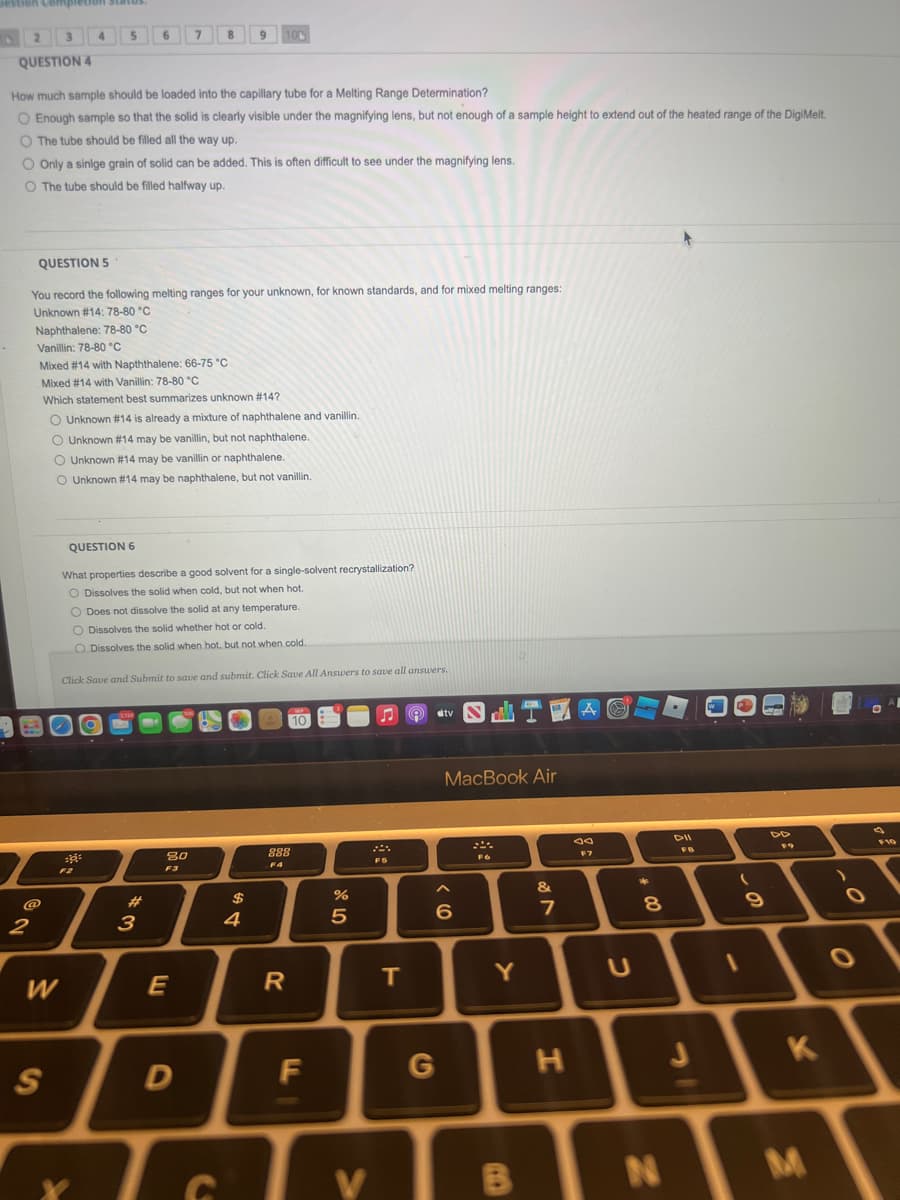2 3 4 6 7 8 100 QUESTION 4 How much sample should be loaded into the capillary tube for a Melting Range Determination? O Enough sample so that the solid is clearly visible under the magnifying lens, but not enough of a sample height to extend out of the heated range of the DigiMelt. O The tube should be filled all the way up. Only a sinige grain of solid can be added. This is often difficult to see under the magnifying lens. O The tube should be filled halfway up.
2 3 4 6 7 8 100 QUESTION 4 How much sample should be loaded into the capillary tube for a Melting Range Determination? O Enough sample so that the solid is clearly visible under the magnifying lens, but not enough of a sample height to extend out of the heated range of the DigiMelt. O The tube should be filled all the way up. Only a sinige grain of solid can be added. This is often difficult to see under the magnifying lens. O The tube should be filled halfway up.
Chapter8: Sampling, Standardization, And Calibration
Section: Chapter Questions
Problem 8.9QAP
Related questions
Question
4 5 6

Transcribed Image Text:Destion Completion statu
2 3
QUESTION 4
2
5
W
How much sample should be loaded into the capillary tube for a Melting Range Determination?
O Enough sample so that the solid is clearly visible under the magnifying lens, but not enough of a sample height to extend out of the heated range of the DigiMelt.
O The tube should be filled all the way up.
S
O Only a sinige grain of solid can be added. This is often difficult to see under the magnifying lens.
O The tube should be filled halfway up.
6
QUESTION 5
You record the following melting ranges for your unknown, for known standards, and for mixed melting ranges:
Unknown #14: 78-80 °C.
QUESTION 6
Naphthalene: 78-80 °C
Vanillin: 78-80 °C
Mixed #14 with Napththalene: 66-75 °C
Mixed #14 with Vanillin: 78-80 °C
Which statement best summarizes unknown #14?
O Unknown #14 is already a mixture of naphthalene and vanillin.
O Unknown #14 may be vanillin, but not naphthalene.
O Unknown #14 may be vanillin or naphthalene.
O Unknown #14 may be naphthalene, but not vanillin.
F2
7
#
8
What properties describe a good solvent for a single-solvent recrystallization?
O Dissolves the solid when cold, but not when hot.
3
O Does not dissolve the solid at any temperature.
O Dissolves the solid whether hot or cold.
O Dissolves the solid when hot, but not when cold.
Click Save and Submit to save and submit. Click Save All Answers to save all answers.
80
F3
9
E
100
D
C
$
4
888
R
10
F
%
5
Tv
V
♫
F6
T
#tv
MacBook Air
6
G
F6
Y
B
&
7
H
A
00
F7
n
с
8
N
DII
FB
J
1
(
9
K
M
)
F10
Expert Solution
This question has been solved!
Explore an expertly crafted, step-by-step solution for a thorough understanding of key concepts.
Step by step
Solved in 3 steps

Knowledge Booster
Learn more about
Need a deep-dive on the concept behind this application? Look no further. Learn more about this topic, chemistry and related others by exploring similar questions and additional content below.Recommended textbooks for you


Principles of Instrumental Analysis
Chemistry
ISBN:
9781305577213
Author:
Douglas A. Skoog, F. James Holler, Stanley R. Crouch
Publisher:
Cengage Learning


Principles of Instrumental Analysis
Chemistry
ISBN:
9781305577213
Author:
Douglas A. Skoog, F. James Holler, Stanley R. Crouch
Publisher:
Cengage Learning